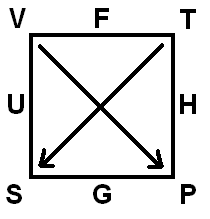Thermodynamic Potentials
From QED
There are some useful mnemonics for remembering things in thermodynamics.
Differential Forms of Thermodynamic Potentials
It can be difficult to remember the differential forms of thermodynamic potentials:
However, there is a fun and easy way to remember these relations. Draw a square, and begin labeling the vertices and sides from the upper left using the phrase:
Very Fast Trucks Have Poor Gear Suspension Underneath.
Then, draw two arrows pointing diagonally downward from the upper left to lower right and upper right to lower left vertices. To read off the relations, take one side of the square and prefix it with 'd' to give find the left side of the equation. Then, the right side of the equation is given by the opposite vertices and the arrows. One term is the opposite vertex label followed by 'd' of the corresponding adjacent diagonal vertex, with the sign given by the direction of travel (so that the sign is positive if going along the arrow or negative if going backward). The other term is found in the same way.
For example, to find the second relation, start on the right side. This gives:
The first term on the right is found by starting at the opposite vertex labeled by 'V.' Travel along the arrow diagonally to 'P' to find that this term ends in 'dP.' Now this gives:
Finding the second term on the right uses the same method, so look at the other opposite vertex 'S' and follow the arrow backward (giving a negative sign) to 'T' to complete the relation:
Maxwell Relations
The Maxwell relations are similarly difficult to remember:
To remember these relations, use the mnemonic phrase:
Put not Some Veal There.
Draw a circle and put the letters of the phrase around the circle in clockwise fashion, treating the word "not" as a negative sign. The relations can be read off by starting at one letter, which becomes part of the numerator of one side of the equation. Choose a direction of travel, and the next letter becomes part of the denominator. The subscript is the third letter encountered. If crossing the negative sign, negate that side of the equation. To find the other side of the equation, start at the letter first chosen, travel one letter over in the opposite direction, and then fill in the other side of the equation using the same rules but travelling in the opposite direction.
For example, starting with 'P' and travelling clockwise, one encounters the negative sign, 'S,' and then 'V.' This gives:
Then, going back to 'P' and moving one letter in the counterclockwise direction, one reads off 'T,' 'V,' and 'S.' This gives the right side of the equation, completing the relation:


























